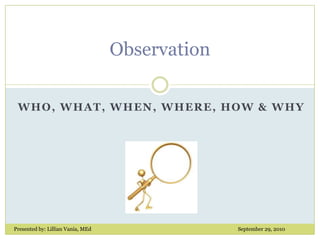
Observation Power Point Presentation 9 10 2010
- 1. Observation Who, What, When, Where, How & why Presented by: Lillian Vania, MEd September 29, 2010
- 2. Williamstown Community Preschool September 29, 2010 Name: 2 hours: Observation, Assessment, and Planning for Individual Need Presenter: Lillian Vania, MEd Observation Who, What, When, Where, How & why
- 3. Welcome Observation Observation Exercise Why observe?
- 4. The Why of Observation(Purpose or Rationale) The primary tool for gathering evidence and notes for later use for analyses, decisions, judgments, and evaluations. 1 A quantitative method of measuring classroom behaviors. To study a specific ability or behavior. Provide information about children, their development, needs, talents, and their environment. 2 Classroom observation- Purposes of Classroom Observation, Limitations of Classroom Observations: Students research teachers teaching observational found classroom behaviors www.newchildcare.co.uk/rationale.html
- 5. The rationale for child observation is to: Learn more about: Child development: Areas: social, emotional, cognitive, physical Sequence: sit, stand, walk, run, Milestones: age range The individual child: Identifying the individual child’s stage of development The range of the individual’s development within the group The child’s individual needs, personality, and talents The child’s health Children’s behavior and effective ways to manage behavior How children learn Identifying sensory or physical difficulties Developing and maintaining a safe and stimulating environment The Why of Observation(Purpose or Rationale) The rationale for child observation is to: Provide information for: Written documentation about the development of an individual child Formal assessment of a child’s learning: Forerunners Emerging skills Moving through stages as school year progresses Planning curriculum
- 6. Children Child: [chahyld] noun, plural chil·dren a person between birth and full growth; a boy or girl The most rapid phase of a child’s development occurs in their first five years of life. These early years are when the brain grows the most: 85% of children’s core brain structure is developed by the age of four. This provides the foundation for children’s future health, academic success, and social and emotional well being. The Who of Observation www.childrennow.org
- 7. The Where of Observation Environment Thinking critically about your environment Where does observation occur? Does your environment always provide you with what you need to see? What are changes you have done to your environment to foster observation?
- 8. How do you know what to observe? Scripted or Required Creative Curriculum Developmental Continuum Unscripted Intuitive Do these two approaches of what to observe work together or separately? Picture Exercise What are you observing in the picture that fits on the continuum? What else are you observing in the picture that does not fit on the continuum? Why is unscripted observation important? The What of Observation
- 9. Observe from a distance without the child knowing they are being observed. Avoid making assumptions Which statement is correct? Annie never shares. Annie has difficulty sharing. Quick note card exercise: Write down an assumption statement/ pass it to your left/ rewrite the sentence to remove the assumption/ share with group Avoid labels Avoid conclusions you are not qualified to make Do not compare children. Remember they develop at different rates Be objective Objective observations state the facts. It can be difficult to remain objective ( we are human, after all) Do not be subjective Subjective observations state an opinion of the observer Identify diversity: children’s talents and needs to succeed in an educational setting The How of Observation
- 10. Planned Observation Choosing when to observe “piggybacks” on the previous concept of scripted versus unscripted observation. Schedule ahead of time and addresses: who, what, why, where, and when Develop a routine and system: For example: Method used to track outcomes to input data into creativecurriculum.net Method used to collect and file paperwork for portfolios Prompts may be used to spur a purposeful action on the parts of the children. For example: Putting specific fine motor activities on tables during center time Hands on activities often found in an early educational setting Prompts have clear value toward assessing achievement via the quality of the skills demonstrated or questions and explanations vocalized by the children as they progress through a task.3 The When of Observation(Planned and Spontaneous Observation) 3. The Eliciting Prompt: Initiating Student Questioning via Spontaneous Observation: LearningLeads, 2004 Designed Instruction, LLC, http://www.designedinstruction.com/learningleads/eliciting-prompt.pdf
- 11. Spontaneous Observation Choosing when to observe “piggybacks” on the previous concept of scripted versus unscripted observation. Group discussion: When does spontaneous observation occur? How does spontaneous observation influence planned observation? What is the end result of these four concepts? Scripted Unscripted or intuitive Planned Observation Spontaneous observation Understanding of the whole child Assessment Communication with parents The When of Observation(Planned and Spontaneous Observation)
- 12. The Next Step: Assessment What do we do with all of this information gathered during observations? Communicate learning and growth of child to parents This is the focus for the 2nd workshop on October 13th Quick overview of workshop Purpose of assessment Types of assessment Narrative Portfolio or Work Sampling Reporting assessment Required format Expanding upon the required format Who is my audience? Is the audience homogeneous or heterogeneous? What does my audience already know? Developmental milestones versus chronological age Next step: Child Study Using observation, assessment, and teacher expertise to describe children in full and balanced ways. A focus on a complex approach of understanding complex human beings; the children who enter our classrooms everyday.